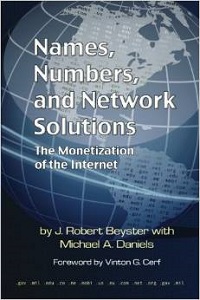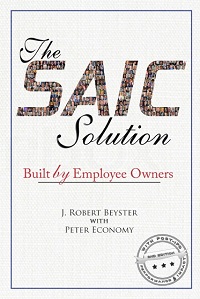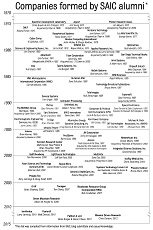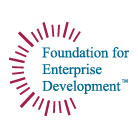SAIC’s Employee-Ownership Continues to Shift; Blasi Speaks
25 Comments Published by Dr. Beyster June 24th, 2009 in Employee Ownership, SAIC, The Book.By now you have probably heard that the SAIC vote on conversion of the preferred stock into regular common stock was approved by the company’s shareholders last Friday. Based on an announcement from the company, The San Diego Union-Tribune reported on June 20, 2009, that 85% of stockholders participated and that two-thirds voted for this change. That means that the proposal apparently passed with about 56.6% of shareholder votes.
This vote means based on reasonable estimates that SAIC’s employee-owners now have less than 50 percent of the voting power and that the public shareholders have the majority. Past experience has shown that it is very challenging to maintain majority or even significant employee ownership over time unless this is treated as a top priority.
In my book, The SAIC Solution, I pointed out four key advantages that we enjoyed over our competition because of the kind of employee ownership we practiced at SAIC. These key advantages included:
- Employee ownership allows a focus on long-term goals.
- Employee ownership helps attract and retain a superior workforce for decentralized growth.
- Employee ownership facilitates the alignment of key corporate constituencies.
- Employee ownership at SAIC promotes corporate flexibility and adaptability to maintain customer focus.
Employee ownership is important because it is fair for all employees to share with other investors and top management in the value that all of the workers created as a total team. Research now provides strong evidence that the combination of broad-based incentives like employee ownership with teamwork, performance management, and highly trained employees contributes to corporate performance and innovation. This evidence shows that employee ownership is also very good for non-employee shareholders and investors.
I have heard the theory that minority voting control and ownership by employees will unleash SAIC’s stock price. I hope the stock price does well but I want to make clear that there is nothing magical about employees owning little of a company. I believe that broad-based employee ownership at all levels was a critical factor in making SAIC so successful in the first place. I hope that the four advantages cited above don’t completely evaporate as the company’s employee-ownership culture continues to shift to one that is focused on public ownership and Wall Street. I will watch with great interest.
Blasi Speaks
I was interested to see that Joseph Blasi, a leading expert in employee ownership at Rutgers University who has done much work with us at the FED, has made some recent appearances in the media. He was quoted in an article on CNNMoney.com and he was a guest panelist on Canada’s Business News Network.
The article discusses the topic of the United Auto Workers union and its reluctance to become owner of large stakes in Chrysler and General Motors. I believe the union is not happy about having large ownership stakes in these two companies because it puts them in a conflict of interest position when they negotiate labor rights. It sounds like they will sell off their stock as quickly as possible, going for the paycheck over the equity stake.
This is a typical response of many unions, although sometimes they will agree to ESOPs. The last time I checked, there were about 12,000 companies with ESOPs, with far fewer operating with the SAIC type of ownership model. We’ll have to see what happens.
The SAIC Solution As Textbook
George Otchere visited us last week. George is an SAIC vice president in charge of small business development in Washington D.C., where he manages the company’s nationwide program. He has been using my book, The SAIC Solution, as a textbook, giving it to each of the small businesses he and his team of people mentor. So far, more than 500 books have been given out.
Last Friday I took my usual trip to Oceanside on Solutions. The weather was great, we saw a few whales, and we got there in two hours. On Sunday the family and I had Father’s Day dinner at the Beach and Tennis Club as did many other local fathers. It was great.





I too watch with interest. I have been with SAIC for 15 years and truly believe that this is exactly what the board wanted – water down SAIC to take away the edge that the competition doesn’t have. When I interview potential employees, I can tell them that it is a great company, but I know that we no longer have that “employee ownership” edge with stock options and an entrepeneurial environment.
I love my SAIC, but am saddened by this vote. BTW – I voted NO to the preferred stock option as did many of my coworkers. I believe the majority of stock was held in other places and shifted the decision in a “predecided” vote.
Concur in mourning our loss of the notion of employee ownership. Plus the barrage campaign to get out the vote for the move was infuriating–I’d like to have a 1oth of the money it cost “us” to call and email ourselves at home to make sure we voted correctly…which I did–against the change.
Employee owned companies that go public almost invariably see not just the voting power of employees but the ownership culture fade as well. And just as invariably, when they go public, they pledge to retain that culture. A lot of the things that employee ownership companies do to maintain that culture are problematic when public. For instance, open-book management principles can run into insider trading problems. Policies that focus on the long-term value of engaged, participative employees, such as resorting to layoffs only as a last resort or spending considerable resources on training, can cut into short-term profits, displeasing investors whose focus rarely extends beyond the next quarter. High employee involvement in decisions at various corporate levels, as well as their own work, is seen in some quarters as bad management. More egalitarian pay structures are disfavored; investors typically what most incentives to focus just on a few key people (the people who “really matter”). Wall Street likes the conventional; companies like SAIC prospered by being very unconventional.
That’s not to say the task is impossible. Many high-tech companies kept their culture (Google, most notably), but investors seem more ready embrace these practices in software companies because it is somehow seen as inherent to the work they do to be more participative. A few other companies, such as Procter & Gamble, have been largely successful in retaining their culture as well. But is is a tough, and usually, losing battle.
Corey Rosen
National Center for Employee Ownership
Dr Beyster,
While I am no expert on employee ownership by any means – having spent many years working with small/medium businesses – one consideration for employee ownership is the trust and initiative factors. I would venture to say that companies, publicly owned and controlled, are more likley to conduct mass layoffs to save money and revert to shorter projections for returns rather than long view for company viability.
The United States Generals used to be the envy of the world – yet due to short term strategies for high returns it only takes a few years to knock them down (General Electric, General Motors, General Mills)
What this will bring will be greater outside oversight and influence over internal policy.
A company that moves away from “employee owned†or in some instances “management owned†has much to benefit from a more open ownership model:
- that employees, and not just management or HR, will finally get a say in the operations.
- that outside involvement can mean different business models can be used his which translates into fewer layoffs
- a business model can finally be updated to reflect more current operational & technological trends.
All too often “employee†ideas or concerns are easily dismissed in favor of more aggressive profit margins. Eventually a culture that supports management and management alone will (hopefully) fade.
It was a move in the right direction.
Damian: I beg to differ with you on the impact of the recent vote. I believe the effects you are expecting will not be there unless the employees can excel even though only upper management is getting the stock and large financial rewards. Admittedly, this is the way most American technology companies operate and hopefully the new system will work at SAIC. In any case — especially in the Washington area — if the employees don’t like the way things are going, they can easily find new employment. I am hopeful that the new CEO’s being in Washington will have a positive impact. — Bob
Blake: I totally agree with you. — Bob
Bruce: Whatever their strategy was, it worked, and the measure to reduce the voting rights of employees passed. — Bob
Carolyn: Despite all your efforts to keep SAIC on the right track from an ownership standpoint, the measure passed. It may be that the votes in one of the retirement plans had a marked impact on the overall vote. — Bob
Dr. Beyster,
It would certainly be a welcome change for employees to receive some of the financial rewards. This is a newer business model that perhaps Walt Havenstein could introduce.
As far as employment in the Washington DC area – it is difficult to find a good, quality company to work for.
The typical environment inside most companies has:
- employees supplying their own PCs and software,
- no reimbursement for customer directed travel (it affects management’s performance metrics somehow)
- the 401k being position & project dependent
- the company allowing only the HMO/PPO closest to the customer worksite to be used (contractual obligations)
- and when projects end (or clearances are due for renewal) people are laid off
It’s just how business is done.
Corey: Thank you for your post on my blog. I appreciate your comments and I agree with most of what you are suggesting. You have seen many employee ownership companies come and go, and have a database of what has worked — and what hasn’t — that is unequaled anywhere else. I have fears for SAIC in the aftermath of this vote. — Bob
This topic of employee ownership is exactly what I’m dealing with as I start a new company and try and ferret out useful details from the sea of advice from lawyers, mentors, and investors. Although everyone gives lip service to employee ownership, most advice is geared toward limited ownership (save it for the investors). It has been difficult to find practical and detailed information on how to preserve as much as possible for employees (I personally agree that this is critical for the long-term culture and success). I will find your book and see if it helps. Thanks.
Paul: Thank you for your response. I’m curious to know what the charter of your new company is. There are a lot of organizations that can help you at little cost to inject employee ownership into your company culture. Specifically, Tony Mathews at the Beyster Institute here in La Jolla would be able to help you. I suggest you visit the Beyster Institute website (http://rady.ucsd.edu/beyster) and start your journey there. — Bob
I think getting rid of the preferred stock was the desired outcome all along and was the reason for going public in the first place, which I also voted against. I know of very few actual employees who voted either to go public or to convert our shares to common stock and I keep wondering, other than the board, who actually wanted this and why???
Has the stock price really gone up, has our equity increased? NO
Has our ability to attract top talent who wants to profit from their own labors increased? NO
Have we actually even gone after any big acquisitions with our cash instead of propping up the stock price, which was one of the reasons for going public? NO
We use to have money in the bank and no debt, now we have more debt than cash.
How has any of this turned out well for the employee owners? It simply hasn’t!
David: I read with interest your post, and I must say your observations are generally the same as mine. The stock price isn’t changing. Although the debt seems to be manageable overall, it’s an anchor that SAIC didn’t need, and it could have been avoided. — Bob
Dear Dr. Beyster,
In my experience and research, most employee-owned companies that get to majority control eventually move to 100% ownership. The ones that don’t usually don’t do so because of an impossible obstacle, like a member of the selling family who wants to continue ownership and involvement. Even Procter and Gamble seems to be moving in that direction, albeit very slowly.
For a company to move the other way when it’s not in distress is a man-bites-dog story. I am wondering, what could have happened to bring about such a development?
The comments on your blog post suggest that the employees really wanted the change, which is hard to believe — they wanted to give up control of their company; or the retirees really wanted it, which makes no sense in such a risky stock market.
I can see that people who wanted to sell right away might want the conversion, since the stock market could have dropped instead of rising as it actually has.
I’d really like to hear your comments on the above, and tell me what am I missing about this story?
Jacquelyn Yates, Editor of Owners at Work
Jacquelyn: I think I’m following your train of thought, and I tend to agree. There was no reason to take the company public because it was self-supporting and there was plenty of cash for acquisitions. It may have been inevitable, however. When it was done, I was not there and my vote didn’t count. — Bob
The conventional arguments in favour of flotation, used with such confidence by fee-seeking Wall Street people (for they are still people, hard though it may be to believe), are bankrupt. They argue that flotation will give access to new capital; but if you look at where business investment comes from (as opposed to capital for acquisitions, which are as likely to destroy value as not) the capital for real investment comes from retained earnings and borrowings. Flotation is not done for that reason.
They argue that supervision is key to stimulate good performance: Wall Street supervises the board, the board supervise the managers, the managers supervise the rest. But the data show which works better: supervision of servant-employees, or participation by partner-employee-owners. ‘The case is closed’ say the economists who look at data rather than theory. Employee owners are more productive.
Wall Street argue that employee ownership will never work, because each employee owner only gets 1/N of the extra he or she puts in, so it will make sense to be a ‘free rider’. They should not judge others by themselves. You only have to work a short time in an employee-owned firm to realise that people identify with their company, and love making it hum. Anyway, as Loren Rodgers pointed out, in a conventional company the employee who makes an extra contribution gets 0/N, so the employee owner gets infinitely more benefit than the normal employee. No wonder they have to depend on supervision.
The real reason why flotation is backed (and then acquisitions) is because of the fees they make. What fees were paid to the brokers and advisers and lawyers when SAIC floated? It’s easy to believe in rubbish when it helps make you rich.
David: I think I understand. By flotation I think you mean taking the company public. If I’m wrong please let me know. I think employees do better in a company that is owned widely by employees than in a company where management tends to distribute the wealth only to other managers. — Bob
So, if this “experiment” in going public fails, will current SAIC leadership be able to reverse the decision and buy back the stock to at least a majority? Just because a company is public should not prevent a continuing culture of rewarding “all” employees with stock rewards, options and the like. Why does this need to stop simply because half the stock is publicly owned. I got the investor/Wall Street pressure comment from some of you above, but really….management still sets policy and therefore have the ability to maintain the culture. Don’t they?
Marc: It sounds like you’ve got a good idea. The only problem with your suggestion is that SAIC is not about to buy back all the stock. Once the company has gone public, which it has, I believe it is going to stay that way for good. It would be too hard to reverse that decision now. — Bob
I’m a late-comer to this discussion, but in response to David Erdal’s comment, I would add that part of the problem with economic theory is that economists generally think that all that matters is money. The argument that employees won’t make good owners because they only receive 1/N of the results of extra effort fails to recognize all of the advantages that are associated with the development of a meaningful “ownership culture” — greater opportunities for involvement in company decision-making, greater information-sharing, greater stability and more job security, on top of the financial rewards. But because economists and Wall Street types only concentrate on the financial aspects, they can’t see all the other benefits (many of which contribute to better economic performance).
Mark: I agree with you. There is much more to employee ownership than the obvious financial rewards that can be enjoyed if a company succeeds and is profitable. Employees also feel more engaged in their work, and their entrepreneurial energy is unleashed, much to the benefit of both customers and the company — and to the nation’s long-term economic well-being. — Bob
15 years since I left SAIC I only found out about this now and I’m stunned. What a sad thing to have happened; it just turns SAIC into yet-another-company.
Employee ownership gave it an edge and a different culture and fostered a very different feeling about working there. Shame.
Andrew: Yes, employee ownership was the “secret sauce” that made SAIC different from the competition. I’m sorry that the culture has changed. — Bob